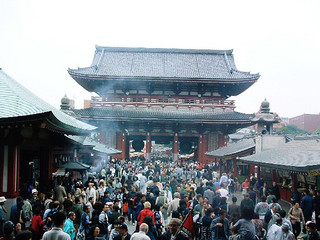Senso-ji
- Founded: 645
- Other Names: 浅草観音 (Asakusa Kannon), 金龍山 (Kinryuu-zan)
- Japanese: 浅草寺 (Sensou-ji)
Sensô-ji, located in Asakusa, is the oldest Buddhist temple in Tokyo, and one of the largest and most famous.
The temple's origins are claimed to lie in the discovery, in 628, of a small, pure gold statue of Kannon in the Miyatogawa (the Miyato River, today known as the Sumidagawa). After this discovery by peasants who had been fishing in the river, a shrine or temple was built for the Kannon; Sensô-ji is said to have been officially founded, and its construction completed, in 645. During the Edo period, when the area first became more densely built-up and developed into a city, Sensô-ji served an important spiritual function, as the chief temple defending the city from evil spiritual energies said to come from the northeast (the so-called kimon or "Demon's Gate"). It is a temple of great importance to both high and low, serving as a tutelary temple of the Tokugawa clan, and unofficially as the chief temple of the Yoshiwara community.
Sensô-ji was originally a Tendai sect temple, but in 1950 became the head of its own Shô-Kannon sect or school of Buddhism, with 25 branch temples and 18 subordinate shrines.
The temple is approached via Nakamise-dôri (仲見世通), a long street today lined with market stalls selling pseudo-traditional tourist goods such as folding fans, yukata, and costume geisha wigs, along with traditional sweets such as manju, and other non-traditional merchandise. The market extends on both sides to other streets running parallel to Nakamise-dôri. At the entrance to Nakamise-dôri (at the opposite end from the temple's main worship hall) is the famous Kaminarimon (雷門, "Thunder Gate"). The red gate with its large paper lantern is an extremely common sight in guidebooks, tourist pamphlets and the like; the lantern is red, and inscribed with "Kaminari mon" on the front, and "Fûraijinmon" (lit. "Wind and Thunder Gods Gate") on the reverse. The gate is said to date to 942, when it was first built by Taira no Kinmasa, and was originally located elsewhere, but was relocated to its current location in 1635 and rebuilt and expanded in 1649 by the Tokugawa shogunate. It has been destroyed time and again, as have most of the city's sights, and the current reconstructed version of the gate dates to 1960. Installed inside the gate are statues of Raijin and Fûjin (Gods of Thunder and Wind) on the front, and Tenryû and Kinryû on the reverse.
After walking down Nakamise-dôri, one comes to the Treasure Storehouse Gate, or Hôzômon (宝蔵門), and beyond that, a plaza with a large incense burner in the center, flanked by small buildings where miko (shrine maidens) sell omikuji (fortunes), omamori (protection charms), and the like. Beyond this plaza is the main worship hall (hondô), where, supposedly, the Kannon statue retrieved so many centuries ago is still enshrined.
A five-story pagoda stands to the left of the main worship hall; the pagoda, along with the main hall, were named National Treasures in 1907, but were destroyed in 1945 and are no longer designated as such in their postwar reconstructed forms.[1]
Beyond the main hall, the complex includes numerous smaller structures and sculptures, not all of them religious works.
References
- Plaques on-site.
- "Sensô-ji." Sekai daihyakka jiten 世界大百科事典. Hitachi Solutions, 2012.
- ↑ Gallery label, "Oni-gawara of the Main Ridge Tile of Sensoji Kannon Temple," Edo-Tokyo Museum.

